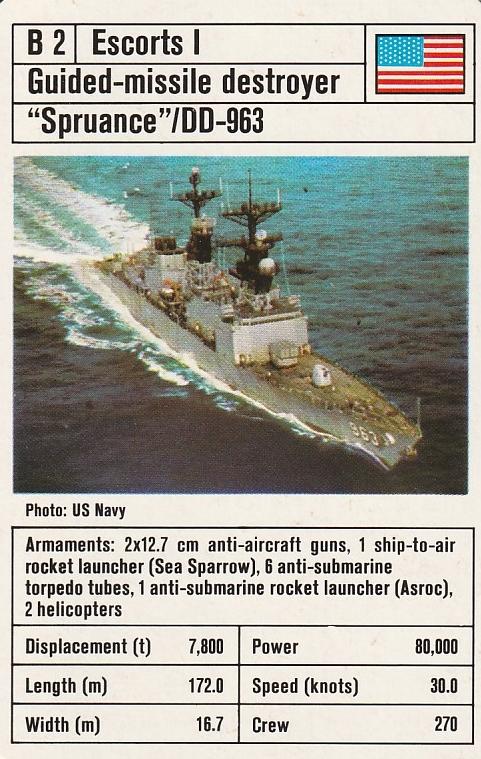Flotilla Tactical Notes Series
By Alan Cummings
One simple, even quaint recommendation: bring back the widespread distribution of flash cards for recognizing allied and adversary platforms and their capabilities. Will this create instantaneous tactical brilliance? No. But it will start giving every Sailor a basic literacy of the threats they are liable to face and the allies they hope to fight beside. On one level, this is simply foundational knowledge in the profession of maritime arms. The more fundamental purpose is to drive a culture and discussion focused on what it means to fight a war at sea.
It is a tried-and-true study method. The front of the card is simple: a profile silhouette of the vessel paired with an actual photo or two. The reverse side contains information like the operating country, primary and secondary missions, armament, top speed, etc. The contents should be robust, but they do not have to be, and indeed should not be, exhaustive.

This is a vastly scalable concept. The simplest version is a single deck of the most common platforms. The alternatives are a wide variety of decks based on country, domain, or region. An unclassified version should be the baseline for widest dissemination and study, while a classified version could incorporate additional or more accurate information. A standard deck can be issued once or, like baseball cards, the collection can be refreshed or expanded annually or some other periodicity. One ambitious approach could entail creating a competitive game with each platform card carrying points for offense, defense, damage control resilience, etc.
There is nothing to guarantee a warm or resounding reception in the fleet. Like any learning resource, these flash cards are a tool—one that offers deckplate leaders a tangible and flexible way to cultivate warfighting mindset and know-how. It will depend on unit commanders and their subordinate leaders to make use of it. If they allow the flash cards to gather dust on the command’s bookshelves, then clearly there will be little benefit. If, instead, they use the cards to engage with their Sailors and get them thinking in terms of friendly and enemy capabilities, then the return on investment offers to be worth it. And especially if those conversations advance to discussions of tactics and warfighting doctrine.
Alan Cummings was an active duty naval officer for ten years in the surface warfare and intelligence communities. He continues to serve in the Navy Reserve. The views expressed here are solely his and do not reflect the official positions of any organization with which he is affiliated.
Featured Image: ARAFURA SEA (Sept. 16, 2022) Royal Thai Navy frigate HTMS Bhumibol Adulyadej (FFG 471), Royal Malaysian Navy frigate KD Lekiu (FFG 30), and Independence-variant littoral combat ship USS Charleston (LCS 18) sail in line-astern formation to conduct anti-aircraft firing serials during Royal Australian Navy (RAN) Exercise Kakadu 2022 (KA22). (Photo courtesy of Royal Australian Navy LSIS Jarryd Capper)


In the age of electronics, simple tools are too often neglected by reason of the lack of profit that can be made from vendors. This approach would seem perfect for sponsorship by an auxiliary group or organization.
Several years ago, I provided business cards for my USCG E3 son. The backs of the cards have the military phonetic alphabet, flag, Morris’s code, and semaphore alphabet. Further, the cards are laminated plastic. I still carry one. In design there is a simple truth, if a thing has intrinsic value, it will be used.
Absolutely, great idea.
In the Navy, there should be a variety of users with differing focus who can benefit from well conceived and updated card decks. In my 32 years of service in the Cold War Navy, I found that the US very often had ineffective visual lookouts when it came to recognition of ships and aircraft encountered. In crises situations, embarked intelligence personnel often produced their own specialized recognition charts and pubs to address threats. In earlier years, the Office of Naval Intelligence produced publications to aid recognition and characteristics of foreign naval ships and silhouettes of merchant ships. Fleet Intelligence Centers also provided some excellent guides to foreign fishing vessels and non-naval units. When properly organized and used in training (in particular of bridge personnel like signalmen and watch officers, these could all assist in essential visual recognition of ships and aircraft that might be encountered. Lapses in production of these essential materials, in a number of cases, contributed to mission failures and difficulties in identifying threats. The closer to combat that you are, the more vital that these simple aids become.
There’s always the Quizlet flashcard app…
https://quizlet.com/ridx/folders/plan-visual-recce/sets
https://quizlet.com/ridx/folders/russia-visual-recce/sets